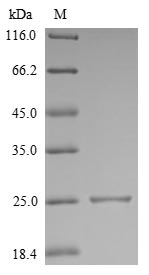Recombinant Mouse Interleukin-18 (Il18) is produced in a yeast expression system, covering the full length of the protein from amino acids 1 to 192. This product features a C-terminal 6xHis-tag, which makes purification and detection more straightforward. The protein appears to be highly pure, with a purity level exceeding 90% as determined by SDS-PAGE. This product is intended for research use only and may provide reliable performance in experimental applications.
Interleukin-18 (IL-18) is a pro-inflammatory cytokine that's involved in regulating immune responses. It plays a key role in stimulating the production of interferon-gamma in T cells and natural killer cells. IL-18 seems significant in various immune pathways, contributing to the body's defense mechanisms against infections and helping regulate immune-mediated inflammatory processes. Studying this protein is likely crucial for understanding immune function and inflammatory diseases.
Potential Applications
Note: The applications listed below are based on what we know about this protein's biological functions, published research, and experience from experts in the field. However, we haven't fully tested all of these applications ourselves yet. We'd recommend running some preliminary tests first to make sure they work for your specific research goals.
Based on the provided information, recombinant mouse IL-18 is produced in a yeast expression system as a full-length protein (1-192aa) with a C-terminal 6xHis-tag. IL-18 is a pro-inflammatory cytokine that requires precise folding, disulfide bond formation, and proper tertiary structure for its biological activity in immune cell activation. Yeast expression systems provide eukaryotic folding machinery that can support disulfide bond formation and some post-translational modifications, increasing the probability of correct folding compared to prokaryotic systems. However, IL-18 is typically produced as an inactive precursor that requires cleavage by caspase-1 for full activity, and the C-terminal His-tag may interfere with receptor binding or protein function. No validation data (e.g., cell-based activity tests, receptor binding assays) are provided. Therefore, while yeast expression increases the likelihood of proper folding, the protein's bioactivity cannot be confirmed without experimental validation.
1. In Vitro Immunological Assays and Cytokine Response Studies
If properly folded and bioactive, this recombinant IL-18 could be used to stimulate immune cells and study cytokine responses. However, if inactive (likely without caspase-1 processing), it will not induce interferon-gamma production or immune activation, leading to false-negative results. The C-terminal His-tag may also interfere with receptor binding even if the protein is correctly folded.
2. Antibody Development and Validation
This application is suitable as antibody generation primarily relies on linear epitope recognition. The full-length protein provides comprehensive epitope coverage. However, if misfolded, antibodies may not optimally recognize conformational epitopes of native IL-18 in biological contexts.
3. Protein-Protein Interaction Studies
If correctly folded, the His-tagged IL-18 could be used to study interactions with IL-18 receptors or binding proteins. However, if misfolded, interaction domains may be altered, leading to non-specific binding or failure to identify genuine biological partners.
4. Biochemical Characterization and Structural Studies
If properly folded, the protein is suitable for biophysical characterization. However, if misfolded, structural data would misrepresent the native properties of IL-18. The C-terminal tag may interfere with some structural analyses.
Final Recommendation & Action Plan
Before using this recombinant IL-18 in functional studies, validate its bioactivity through cell-based assays (e.g., measuring interferon-gamma induction in appropriate cell lines) and confirm folding via biophysical methods (circular dichroism, size-exclusion chromatography). If validation confirms activity, proceed with applications, noting potential tag interference. If inactive, consider using caspase-1 to process the protein to its active form or obtain a commercially validated active IL-18 standard. For immediate use, antibody development can proceed with the understanding that antibodies may require validation against native protein. Always include appropriate controls (e.g., known active IL-18) in experiments to ensure reliability.






